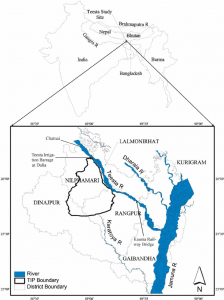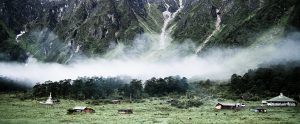Drainage system and River of Sikkim
- Sikkim is a small Himalayan state in north-east India situated between 27degree 00’ 46″ to 28 degree 07’ 48″ N latitude and 88 degree 00’ 58″ to 88 degree 55’ 25″E longitude with geographical area of 7,096 sq km constituting only 0.22% of total geographical area of India.
- It has a human population of 5,40,493 as per Census, 2001, which constitutes only 0.05% of India’s total population.
- The state is somewhat rectangular in shape with maximum length from north to south of about 112 km and maximum width of 90 km from east to west.
- Sikkim is bounded in the north by the Tibetan plateau, by China (Tibet) on the northeast, by Pangola range of Bhutan on the southeast, by Darjeeling district of West Bengal on the south and Singalila range and Mt. Khangchendzonga on the west and northwest.
- Entire state of Sikkim constitutes upper basin of Teesta river except for a small area of 75.62 sq km in extreme southeast that of Jaldhaka river, which originates in East Sikkim and flows through West Bengal parallel to Teesta river to meet Brahmaputra river.

- In southernmost part of Sikkim, Teesta river flows in southwest direction and defines the inter-state boundary between Sikkim and West Bengal up to Melli Bazar where it is joined by Rangit river which drains West Sikkim district.
- Rangit river, the largest tributary of Teesta river in Sikkim, from Naya Bazar point flows in southeast direction and marks the interstate boundary between Sikkim and West Bengal in the southwest.
Teesta River
- One of the rivers that almost flow right across the length of Sikkim is the Teesta.
- It’s major tributary is the Rangeet which originates from the Rathong Glacier, meets it at the border between Sikkim and West Bengal.
- Teesta originates from the Cholamu lake where Teesta is hardly a stream.
- No one can imagine that this innocuous looking stream would transform into a thundering mighty river less than a hundred kilometers downstream.
- The source of the Teesta is the pristine Tso Lhamu Lake in North Sikkim, some 5,300 metres above sea level.
- The glacial waters then move downwards to meet Zemu Chu just above Lachen village and then rushing down deep gorges it meets Lhachung Chu at Chungthang.
- At Mangan, the river is joined by the Talung Chu as it continues its journey down, finally reaching Singtam in East Sikkim, becoming slower and widening to almost double its width.
- Further down at Melli, the Teesta merges with the river Rangeet which is born of the Rathong glacier in West Sikkim, before entering the plains of North Bengal and eventually joining Brahmaputra in Bangladesh.
- During monsoons the otherwise innocuous looking rivers of Sikkim become swollen, swift, muddy and dangerous.
- The rivers are narrow, serpentine and full of rocks and hence are not navigable.
- Because of swift currents hitting rocks, the rivers are very noisy and can be heard for miles together.
- The Teesta finally joins the Bhramaputra in Bangladesh.
- The rivers are fed by snow melting on the mountains as well as rain that accumulates in the catchment areas during the monsoons.
- Human settlements usually must exist above the level of rivers and hence even if flooding takes place life and property remain safe.
The Rangeet or Rangit
- It is a tributary of the Teesta river, which is the largest river in the Indian state of Sikkim.
- The Rangeet river originates in the Himalayanmountains in West Sikkim The river also forms the boundary between Sikkim and Darjeeling district.
- A perennial river, it is fed by the melting snow of the Himalayas in early summer and the monsoonrains in June–September.
- It is popular among rafting enthusiasts owing to its turbulent waters.
- The river flows past the towns of Jorethang, Pellingand Legship.
- During its final few kilometres, it joins the TeestaRiver at a confluence known as Tribeni, which is a popular picnic spot.
- The Rangeet River has an NHPChydropower plant with the capacity of 60 megawatts (80,000 hp) capacity in Sikkim.
River Rangpo
- It is a river in the Indian state of Sikkim.
- A tributary of the Teesta River, it is fed by the Rangpo chu.
- The town of Rangpo in Sikkim lies on River Rangpo north bank.
- The river forms the border between Sikkim and West Bengal states at Rangpo town.
- There is no separate name for the town in West Bengal that lies on south bank of the river and therefore it is also called Rangpo.
- The river runs through most of East Sikkim and a few parts of the Darjeeling District of North Bengal.
- This tributary flows mainly from east to west with a variable channel pattern including braided, meandering, straight, gorge and blocked lake.
- Landslides are very common along the river bank as cliff-like bedrocks are considerably exposed along the river valley wall.
- Its confluence with Teesta River is immediately downstream of Rangpo town.
The Talung River
- It is an east-south east flowing river in the North Sikim Himalayas.
- It originates at the Talung-Tonsyong Glacier’s confluenceat the meeting point of Talung and Tongshiong River & then flows east south east to meet the River Teesta near Singhik, North Sikkim of India.
- The upper catchment is fed by a number of streams and rivulets.
- These streams & rivulets flow from the southern part of Simvu-Sinialchu region to meet the main river.
- Another tributary which feeds the main stream flows from the Zorpetam mountain valley.
- Zorepetam valley is a typical inaccessible mountain terrain in the east of Pandim and Tinchenkhang.
- Number of River of Sikkim originates from this region.
- Owing to the complexity of the river systems its name in its catchment area changes from place to place.
- According to records it is Rukel Chu at first, then Rungayang or Rongyoung Chu and thereafter Talung River or Tholung Chu till its confluence
The Jaldhaka River
- It is also known as Dichu River in earlier times, is a trans-boundary river with a length of 192 kilometres that originates from the Kupup or Bitang Lake in southeastern Sikkim in the eastern Himalayas and flows through Bhutan and the Kalimpong, Jalpaiguri and Cooch Behar districts of West Bengal, India.
- At that point the river enters Bangladesh through the Lalmonirhat District and then joins with the Dharla River until the Dharla debouches into the Brahmaputra River near the Kurigram District.
- Due to the river’s wandering over several international borders, only a small length of the river lies within Bangladesh
The Lachen River
- It is a tributary of the Teesta River in the state of Sikkim, India.
- It is one of the two main tributaries of the Teesta along with the Lachung River, which rise on opposite sides of the Donga Rangein neighbouring Bhutan and converge in Chungthang in the North Sikkim district.
The Lachung River
- Itis a tributary of the Teesta River located in the North Indian state of Sikkim.
- It is a chief tributary of the Teesta, which is an important river in Sikkim along with Rangeet River.
- The village of Lachungis perched on the craggy bank of the river approximately 23 kilometres from Chungthang. It is at Chungthang where the Lachung and Lachen rivers converge and give rise to the Teesta.
- The river is 2,500 metres (8,200 ft) above sea level.
Drainage systems
Drainage systems, also known as river systems, are the patterns formed by the streams, rivers, and lakes in a particular drainage basin. They are governed by the topography of the land, whether a particular region is dominated by hard or soft rocks, and the gradient of the land.
Teesta River Basin Information
- The river Teesta is one of the main Himalayan rivers and originates from the glaciers of Sikkim in North at an elevation of about 5,280 m.
- The river rises in mountainous terrain in extreme north as Chhombo Chhu, which flows eastward and then southward to be joined by Zemu Chhu, upstream of Lachen village near Zema.
- The river takes a gentle turn in southeast direction and meets Lachung Chhu at Chungthang where it takes the form of a mighty Himalayan river.

- Teesta, therefore, is the main river of the state with its several tributaries viz. Zemu Chhu, Lachung Chhu, Rangyong Chhu, Dik Chhu, Rani Khola, Rangpo Chhu and Rangit river and constitutes an extremely important resource of the state.
- After the confluence of Teesta river and Lachung Chhu at Chungthang, the river gradually widens and takes a strong westward turn upstream of Tong and after flowing down to Singhik, the river drops from 1,550 m to 750 m.
- At Singhik, the river receives one of its major tributaries, Rangyong Chhu on its right bank, which originates from the Talung glacier, a part of the Khangchendzonga mountain range.
- From Singhik, the river flows southwards to Dikchu with a 200 m drop through a very deep valley for about 30 km.
- From Dikchu onwards, the river takes many sharp and wide curves and flows down to Singtam with a further drop of about 200m.
- Rangpo Chhu, which drains the Chhangu lake area in East Sikkim joins Teesta river on its left bank at Rangpo. Downstream of Rangpo, Teesta river widens and is joined by Rangit river at Melli Bazar on Sikkim-West Bengal border.
- From Melli Bazar downstream, the river leaves the hilly terrain and enters the plains of West Bengal at Sevoke near Siliguri. Teesta river ultimately drains into Brahmaputra at Teestamukh Ghat (Kamarjani-Bahadurabad in Rangpu district of Bangladesh) and traverses a distance of about 400 km from its origin.
- Teesta and most of its tributaries are flashy mountain rivers and carry boulders and considerable quantity of sediment. The flow is turbulent and characterised by high velocities.
- Throughout its course in Sikkim, Teesta and its tributaries flow in very narrow and deep valleys having precipitous hill slopes, except where the tributaries join the main stream.
- The hill slopes are mostly friable and landslips are very common throughout the basin.
WATERSHEDS OF TEESTA BASIN IN SIKKIM
- The main Teesta while flowing from north to south divides the state into two parts.
- Teesta drainage basin in Sikkim cover an area of 7,020.38 sq km of Sikkim and 75.32 sq km of the state is under Jaldhaka river watershed, which is not the part of Teesta basin. In order to understand the profile and behaviour of the prominent tributaries of Teesta river basin in Sikkim, Teesta basin was divided into its major tributary watersheds.
- The entire Teesta basin falling in Sikkim has been delineated into 17 watersheds following the conventional methodology of delineation based upon drainage order classification.
- For this Survey of India toposheets at 1:50,000 scale were used, with ridge line demarcating the boundaries between adjacent watersheds.
- These watersheds vary in size and shape depending upon the drainage pattern in a particular watershed.
 y causing orographic rainfall and snow fall.
y causing orographic rainfall and snow fall.